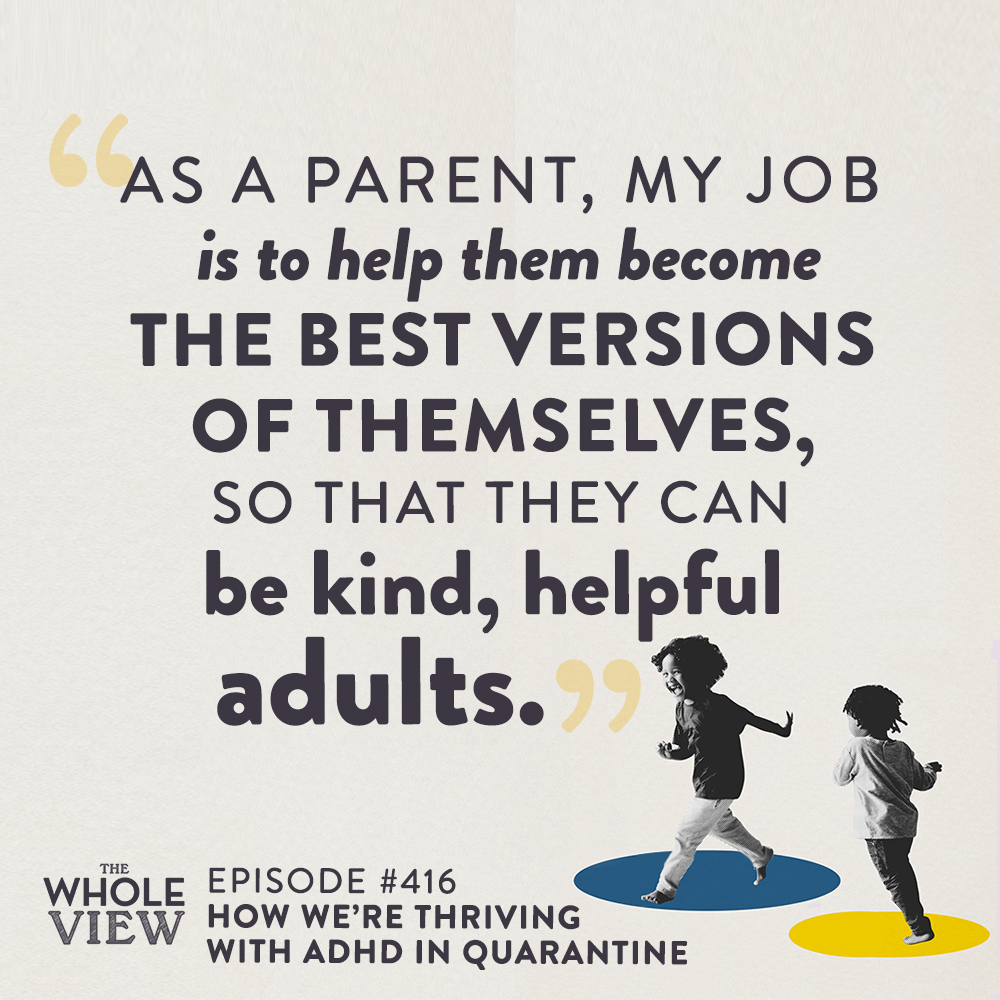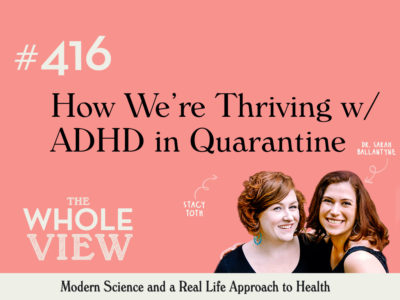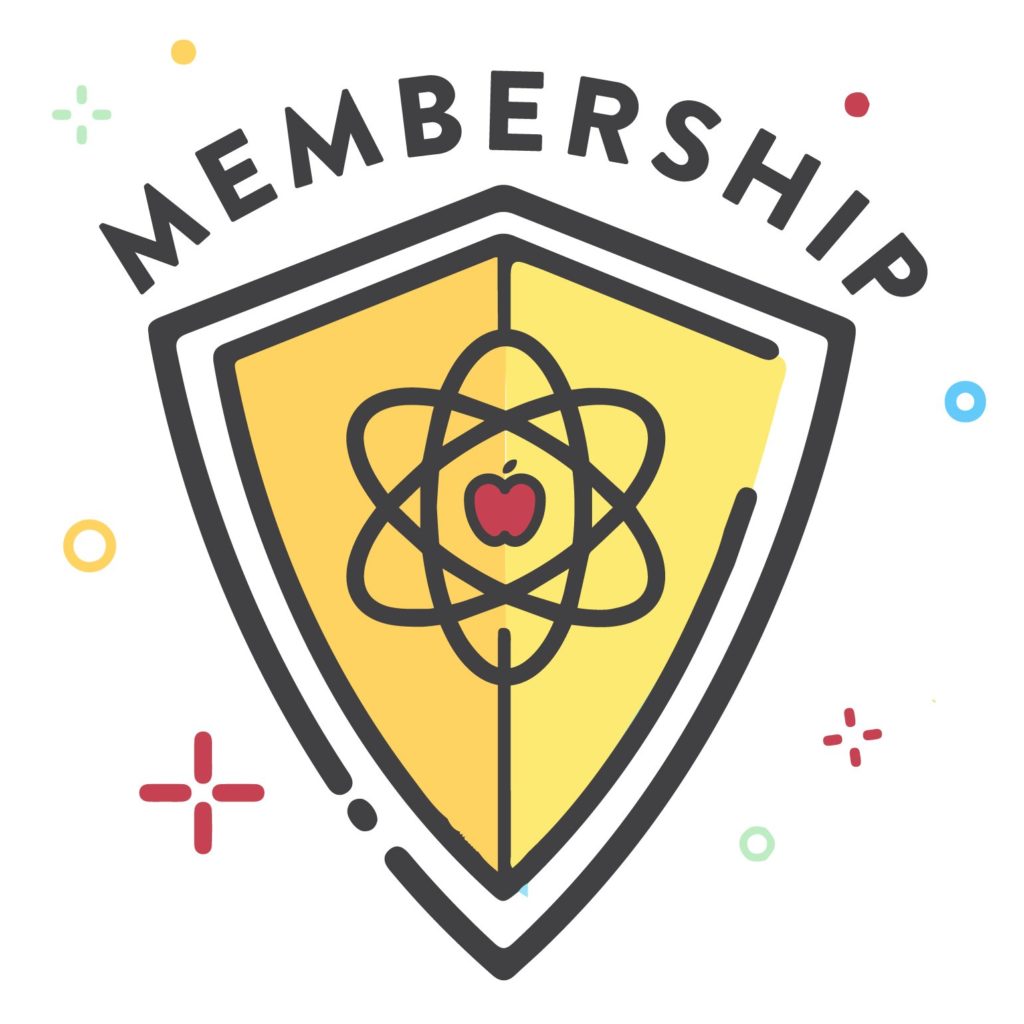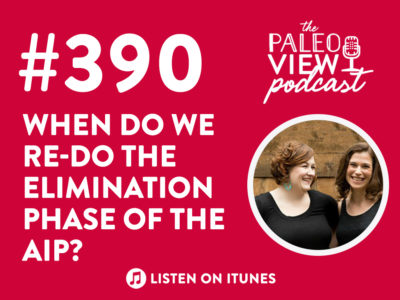Welcome to episode 416 of The Whole View. In this week’s episode, Stacy and Sarah share the ways in which their parenting strategies have evolved during this unique season in life. Stacy answers a listener’s question about practicing patience with ADHD/ADD family members and shares her tips on how to set children up for success. And Sarah tackles the latest science surrounding ADHD/ADD symptom management options. Tune in below!
Table of Contents[Hide][Show]
- The Whole View, Episode 416: How We’re Thriving with ADHD in Quarantine & Virtual School
- Listener’s Question
- Stacy’s Experience
- Communication is Key
- Patience
- Pick Your Battles
- Creating Space
- Sarah’s Experience
- Routines
- Creating a Process
- Phrasing & Cues
- The Lifestyle Things – Family Meetings
- Movement & Diet
- Supplements
- Omega-3 Supplementation
- Anoter Listener Question
- Vitamin A Toxicity
- The Latest Science on Coffee
- Medication
- Closing Thoughts
If you enjoy the show, please review it on iTunes!
The Whole View, Episode 416: How We’re Thriving with ADHD in Quarantine & Virtual School
Welcome back to the Whole View, episode 416. (0:27)
As our regular listeners can tell, it is opposite day, as Sarah is kicking off the podcast.
This week we are going to be talking about Stacy’s experience with children with ADHD, and how they have been handling quarantine and virtual schooling.
Stacy has received this question from a lot of people, especially as we are all getting ready for another school year to begin.
Sarah’s kids’ start date for school was delayed by two weeks so that all of the teachers could get training on the virtual platforms.
They are in the ramp-up to school phase in their home.
In Virginia, schools were set to begin in August, but have been pushed by a two-week delay as well.
Everyone is looking at how to set their families up for success.
Save 70% Off the AIP Lecture Series!
Learn everything you need to know about the Autoimmune Protocol to regain your health!
I am loving this AIP course and all the information I am receiving. The amount of work you have put into this is amazing and greatly, GREATLY, appreciated. Thank you so much. Taking this course gives me the knowledge I need to understand why my body is doing what it is doing and reinforces my determination to continue along this dietary path to heal it. Invaluable!
Carmen Maier
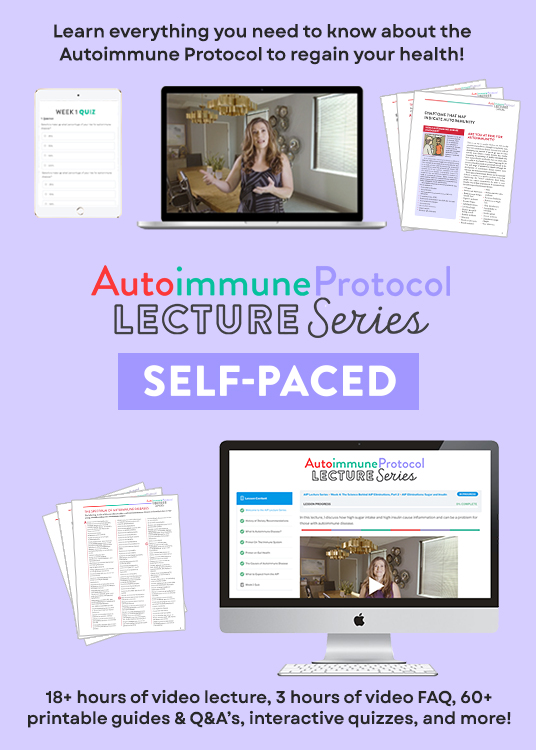
We are going to talk about how Stacy’s family has worked to set themselves up for success.
Listener’s Question
This week we have a really great question from Brooke. (2:35)
“Long time podcast listener – yes, I’ve stuck with you since the early days and love how your podcast has evolved over the years.
I’m a mom of 3 boys all with varying degrees of ADHD.
My husband has more than a dusting himself but is not formally diagnosed.
Stacy, I loved your description of living in a house of 80%ers – it made me giggle because it totally resonated.
I’d love to hear more about how you look after you, maintain some semblance of normal family life, deal with ADHD behaviors in public and live in a house that’s not a tip when you’re surrounded by ADHD.
In short, how do you not lose your mind with the challenging aspects?
Knowing that the men in my life didn’t choose this just doesn’t cut it anymore.
Many thanks, Brooke.”
Stacy’s Experience
To introduce everyone to Stacy’s experience with this, she has two children – one with ADD and one with ADHD. (5:05)
Her husband is formally diagnosed with more than a dusting.
This also runs on his side of the family, with Matt’s brothers all having varying forms.
Stacy wants to note that these are almost always paired with sleep and mood disorders.
A lot of depression and anxiety also pairs in with these conditions.
So when we think about an attention disorder we think of a child who is a busy bee, so to speak or someone who can’t focus on a test.
It is a lot more than that though, with a formal diagnosis it affects more than just their ability to focus on simple tasks.
As we talk about the context of this, it is important to remind yourself that this is a medical condition and that it really can’t be helped.
While we can do things to modify the lifestyle factors, likely a person in your life that you love has conditions that have some sort of aspect of this.
Stacy would be surprised if there was someone who didn’t know someone with depression at some point in their life.
She also shared the way that she processes her feelings around these conditions.
In this week’s episode, Stacy hopes to shares tools that are applicable to those who have family members with one of these conditions.
Communication is Key
First things first, is to communicate. (10:34)
If you are not talking about something, that is just making it worse.
Sometimes it is hard to say you are frustrated or to find the words, but this is something that Stacy really encourages in their household.
This is not something to be ashamed of or embarrassed by.
In fact, it’s helpful to be able to point to an explanation of behavior.
For example, one of the brothers who doesn’t have ADD/ADHD gets quite frustrated when another gets distracted and doesn’t do chores.
There’s a feeling of inequality that can then be explained with a medical condition.
This helps to serve as an explanation, not an excuse.
Patience
The next thing is patience. (12:27)
Stacy knows this is a hard one, she is there, but she expects to need to repeat herself before she is truly heard.
To set people up for success, Stacy sets people up with jobs that are consistent, they have a list, they have things they can refer back to for reminders, and they have tasks that are best suited for them.
Stacy reminds herself that it’s not intentional, that their brain literally forgot what they were doing and they went on to do something else.
However, these are tasks that each of the kids picked from a list of everything that needed to be done.
Stacy has raised her kids to be independent, to feel empowered, and to feel that they can succeed in the things they know they have done before.
As they have a new family member, the chores that this family member has are things they have done before.
Again, it boils down to setting them up for success, empowering them, and building their confidence.
It minimizes frustrations to set kids up for success and pride.
With ADHD, this has been critical to their success in quarantine in general.
They approached this season in life as a team and looked at all the shared responsibilities and how to support each and every member of the family.
Most of the time they are happy to help, and they do get an allowance as well.
Stacy and Matt use an app called Green Light, which allows them to manage their chores and pay them via a card that they can load.
Don’t have unrealistic expectations.
We as adults are tired of this pandemic as well.
Pick Your Battles
This leads Stacy to her next point, which is to let somethings go and pick your battles. (20:50)
Stacy is far less concerned with the boy’s beds being made, than she is with them being kind to one another or if they are generally, genuinely being helpful.
So this is the perspective she tries to maintain when she is frustrated.
Stacy will often ask herself if something is worth it when she finds herself angry or frustrated.
One example that Stacy shared is one of her kid’s clothing preferences and giving him room to make those choices.
What he is wearing in not the battle Stacy wants to pick.
It is far more important to Stacy that when her son is outside he helps their elderly neighbor carry her bags into her house, as opposed to what he is wearing.
As a parent, Stacy feels that it is her job to help them become the best version of themselves that they can be.
To also shape them into kind, helpful adults.
She doesn’t want to change them to fit the mold that she wants them to be.
One of the things that Stacy does is ask herself, “if this was a behavior that they were exhibiting as an adult, would it be appropriate and would it be beneficial?”.
Creating Space
Sarah asked Stacy if she has any strategies for how to defuse anger in the heat of the moment. (28:58)
Stacy does try to do breathing.
Just as a situation is starting to build up and overwhelm you, it is helpful to do that deep breath through the nose and out the mouth.
If you do a deep pattern a few times in a row, it will give you a break to collect yourself before you react.
The thing that is more effective for Stacy personally that her kids and husband respond to is to walk away from things when they are not time-sensitive.
When things are not going in a positive direction, they take a break and talk about it again in a few hours.
Matt does really well if he goes outside and takes a walk to separate himself from what is physically happening.
Self-care resonates with Stacy when she is taking a break.
Creating any space where you can give yourself a break is going to really help.
Use these techniques to ask yourself if your expectations are reasonable, if you could create flexibility or small wins, or can you better understand their perspective.
Whatever is happening to you, you are not alone.
This just happens to be a concentrated season when you feel like you can’t get a break.
So you need to create that space to take your break.
Sarah shared that one of the things she has struggled with most during quarantine is the loss of alone time.
There is an overstimulation aspect.
As a family, they have had to have a conversation about how to respect each other’s personal time and space.
This ensures that when they come together as a family, that time actually serves as quality family time.
It has been helpful to have spaces where they each could retreat to while they defuse the stuff that is meaningless.
Sarah’s Experience
Everyone in Sarah’s family is an introvert and everyone needs their recharge time by themselves. (36:14)
They all get more energy from time alone.
In addition to being introverts, they are all very social, so also need social time together.
If they haven’t had kind and respectful social time if they haven’t had recharge, alone time.
So this has been one of the things they have had to navigate over the summer months.
And they will again have to find a new system as the kids begin school in a few weeks.
Sarah’s girls happen to be planners and having an idea of what to expect really helps them.
Knowing what to expect helps them adjust better to change.
Right now they are talking through the different interpretations of the academic schedule and what they could mean for their daily routines.
In Sarah’s house, routine is essential.
Sarah shared information from an interview she recently watched that featured a psychologist discussing some of the challenges with quarantine from a mental health perspective.
One of the things that he said is that the brain doesn’t know the difference between a big decision and a small decision.
The brain doesn’t know the difference between the higher levels vs. lower levels of stress when making a decision.
When we can take decisions out, and rely on routine, this helps to decrease the decision burden on the brain.
This is something that Sarah has really internalized in terms of how they approach their time when every day feels the same.
Routines
Stacy completely agrees with having some sort of schedule, list, or plan that the kids can expect. (40:01)
Regardless of age, or conditions, or personality types, all humans want to know what to expect.
It feels like chaos for most people to go into the day without a plan.
Stacy sets the expectation of what she needs to accomplish each day, and she does the same for the kids.
For the kids, she makes it clear what needs to be accomplished before they have screentime or before they do ‘x’.
This way it is up to them to set the pace on their tasks.
Otherwise, there is not much else for them to do besides playing together, being active, reading, etc., which are all things Stacy is in full support of.
This also allows them to have a little sense of control and independence that is really needed for kids as they get older.
Stacy noted how you could set up a toddler for success in their schedule as well.
This can look different and be tailored to each family, but some kind of structure is key for all humans.
The only thing that Stacy would add to Sarah’s alone time recommendation is to add in some quality positive time.
You need to proactively create that time that you are spending together either playing games, telling stories, or watching shows together.
Cultivate positivity around the time that you spend together so that when you are together as a family, it doesn’t feel like is all you are doing is chores or nagging.
Creating a Process
The last thing that ties into all of this is to create a process that works for the child. (44:22)
Specifically speaking within the context of ADD and ADHD, oftentimes by instinct we do the things that work for us.
However, your child might thrive in a different environment, so it is really important to tailor and figure out exactly what is ideal for that child.
Stacy knows that this is difficult and is something that she continues to work on.
It is our job as adults and parents to bend what we need to do to at least meet our child in the middle to help them be the most successful as they can be.
You can adjust and tailor this over time, and it will get easier as they get older.
For Stacy, for her child to process what she is asking of them, she has to make sure that they are looking at her in the eyes as she talks to them.
She has to go to them and squat down to their level.
Stacy also has to be able to read if/how they are distracted and connect with them physically while she is talking to them to further make sure she is heard.
Sometimes she will also have her child repeat what she said to make sure they heard her properly.
The other thing that Stacy needs to learn and adjust to is to not delegate more than two things to her child with ADHD.
Stacy will delegate one task and then have her child report back once that is done, and delegate another task accordingly.
This is how her child is successful, and he has gotten better.
They have made a lot of progress and they will continue to make progress as he gets older.
But you have to meet your kids where they are, no matter what their difficulties are.
This has been Stacy’s guide to success.
Phrasing & Cues
One of the things that are important as you communicate and have patience is to have words for when things are going in a direction that is not positive. (49:34)
When Stacy sees impulse control is a problem, she will say to them, “it seems like you are not in control of your body why don’t you go take a break.”
In Stacy’s house, they have this phrase that they use that helps them recognize what Stacy means and what she is talking about.
This makes it so that Stacy doesn’t have to explain herself each time or point out the bad thing they did.
Is all she has to do is say, “Hey – it looks like you are having a moment. Let’s take a break and we will come back together later to talk about this.”
They also have code words in their family when people are being triggered for things.
Each member of the family uses the code words when they need to, and everyone else respects the rules associated with that word accordingly.
The Lifestyle Things – Family Meetings
Some of the things that Stacy wants to lead into that Sarah can provide input to are the lifestyle things. (52:17)
Family meetings are one of those lifestyle things.
These are used as a way to connect, to get on the same page together as a family, and are not places where Stacy yells at people.
The family meeting is not the place for that.
If things start to get frustrating and voices become elevated, Stacy and Matt will try to pull it back a little bit as parents.
They will encourage their kids to use the ‘I feel’ phrase to express what they are feeling at that moment.
Creating a forum where everyone feels like they are heard is really critical for not letting situations be a snowball that gets worse over time.
They call family meetings for everything.
Stacy tries to make sure it is not a negative space.
Movement & Diet
Some other lifestyle and diet changes, which Stacy is not going to go super deep into because we discussed them in this episode. (54:29)
You can hear the growth and progress in Cole’s life from that episode to now.
One of the things that were big for Cole when he was younger was to provide relief for the physical need for movement.
They did this by using a yoga ball for a chair, providing a tool they could physically fidget with, and ensured that there were breaks.
People with ADHD and ADD have physical energy that builds up in their body and they need physical breaks.
Going gluten-free and limiting dairy were also helpful pieces they incorporated.
They did eliminate dairy for a long time but have brought back high-quality dairy in high-fat forms and in limited quantities.
Stacy has also found that avoiding food dye is also very helpful for her kids.
All of these things help them maintain the highest level of control over their body.
Sarah shared her experience with how one of her daughters react when she eats something with food-dye.
The best way to gauge what your child is affected by is an elimination diet.
There are a million different tests that your pediatrician can run to see what your child is allergic to.
However, the only way to see how your child reacts to things is to remove the foods in question from their diet and reintroduce.
Supplements
We did a show dedicated to melatonin, which you can find here. (1:01:09)
Melatonin has been so helpful because adequate sleep is critical.
Kids with ADHD and ADD often have a difficult time sleeping, especially if they are on a stimulant medication.
Even without medication though, it has been so helpful for Wesley.
He gets anxiety at night and goes through phases when he needs melatonin at night.
Probiotics, because as we have talked about on this show, gut health is health.
He takes Just Thrive probiotics just like Stacy does.
The other two things that Stacy recently mentioned are fish oil and coffee.
Sarah has some science on these two things though, so Stacy is going to turn things over and let her explain the research behind these two supplements.
Omega-3 Supplementation
Coffee needs an update since episode 145 was the last time we covered that, and we haven’t covered fish oil supplementation for ADHD in greater scientific detail. (1:02:55)
There have actually been enough studies now looking at fish oil supplementation as a primary approach to ADHD and ADD.
We have studies showing that people with ADHD tend to have much lower levels of the long-chain omega-3’s, especially DHA in their blood cells.
There are researchers that actually think that a deficiency in DHA and EPA drives the neurotransmitter imbalances that are causing the behavioral manifestations and cognitive manifestations of ADHD.
Studies have shown that supplementation of doses of at least 500 mg per day very significantly improves both the clinical symptom scores, as well as cognition measurements that are associated with ADHD.
Anoter Listener Question
Sharon asks, “In your recent podcast you discussed your doctor’s recommendation to increase your son’s fish oil. (1:09:00)
You said he was taking Rosita cod liver oil and I was immediately concerned.
Fish oil and cod liver oil in particular has some major differences.
Cod liver oil is extremely high in Vitamin A.
It can be toxic in large doses and cod liver oil has a large dose, according to WebMD.
You probably know this and are doing just fine, but I wanted to give you this info, just in case.”
Vitamin A Toxicity
Sharon is absolutely right that there is a big difference between any fish liver oil and fish oil. (1:09:33)
It is because of the oil from the organs versus the oil from the muscles.
They are both very high in omega-3’s, but fish liver oil has a much higher vitamin content.
It has quite a bit of vitamin A, but also a high dose of vitamin D, and it has a little bit of E and K as well.
This is one of the reasons why Sarah chooses cod liver oil because vitamin A dietary insufficiency is very common.
A teaspoon serving of Rosita extra virgin cod liver oil has about 3900 IUs of vitamin A.
That is 78% of the adult daily value.
It also has 395 IUs of vitamin D, which is 98% of the adult daily value.
However, there is a really interesting common misconception about vitamin A toxicity.
The US Institute of Medicine’s daily tolerable upper-level intake for vitamin A has been set quite low.
Some vitamins have what is called a UL, an upper level, where they basically say that staying below that level means that you are in a safe zone for avoiding toxicity levels.
So the upper level for vitamin A is different for age and gender.
However, for children ages 9 to 13, it is about 5600 IUs per day, and for adults, it is about 10,000 IUs per day.
This is set based on a couple of different things.
The things that they are looking at to set the upper level are changes to bone mineral density, birth defects, and abnormalities in liver health.
So the data that is going into the UL is basically very narrowly defined.
What is important to understand about vitamin A is that toxicity is extremely rare in the context of whole foods.
It is basically been seen in the consumption of seal liver, polar bear liver – forms of the liver that can literally have millions of units of vitamin A in a very small amount.
And it is typically seen in the context of supplementation in conjunction with vitamin D deficiency.
Vitamin A toxicity requires very high doses of vitamin A.
So in children, we see acute vitamin A toxicity at 300,000 IUs a day, which is an accidental dose.
If you are going to be taking high doses of vitamin A, it is important to know where your vitamin D levels are at.
Test don’t guess – and then retest.
There is a growing body of scientific literature showing that vitamin D insufficiency and deficiency is associated with ADHD and that supplementation has been shown to improve symptoms.
The Latest Science on Coffee
Sarah was really interested to see what new research had been published since we did episode 145. (1:17:55)
There are more animal studies looking at caffeine and ADHD.
Caffeine was first adjusted as a management tool for ADHD in 1973, and there have been a variety of studies that have looked at caffeine pills or coffee for symptom management.
Most of the studies have been uncontrolled, and most have been relatively small.
Caffiene is psychoactive for all of us.
Sarah explains how it works in the body, in addition to the downstream effects.
Studies have shown that caffiene consumption works best as a low dose.
Optimal doses are somewhere around 150 milligrams of caffiene per day.
So the studies show that coffee is more effective than nothing, and probably not as effective as various medication options for ADHD.
Of course, the side effects of caffiene consumption are much more tolerable than some of these medications, as some of these medications have really undesirable side effects and higher rates of adverse reactions.
There is a call for coffee to be reconsidered as the first course of action in treatment.
Sarah noted that it would be ideal to address the nutrient deficiencies that are contributing to the neurotransmitter imbalances.
Then use caffiene as a management tool.
Sarah explained the findings from this study released in April, in addition to this paper from 2018.
If you look at the body of scientific literature over the last five years, there is still the same need for big scale, randomized placebo-controlled, clinical trials.
However, the mechanistic understanding has become more robust and has made a stronger case for someone to go and do those big clinical research trials.
Stacy has found it to be more effective and less effective at different times for the kids.
It is one of those things that as you are looking to help your ADHD, the need fluctuates.
And Stacy does feel like it relates to the other things you are doing in your life as to how much caffiene you might need.
Medication
Stacy will say that they were fortunate that none of their boys have gone on medication. (1:26:24)
They have been able to focus on the lifestyle and supplements they have talked about throughout this episode.
Stimulant medication for ADD and ADHD often have side effects that Stacy is trying to avoid.
Matt has been on them from a young age and they are very difficult to come off of as an adult.
The side effects become more dangerous over time, which is also a really hard thing to deal with.
If you are feeling like you need additional support now that you are at home, you could ask your medical professional about a non-stimulant medication that can now potentially be used.
Stacy noted that what is really great about it is that it is not a controlled substance.
Closing Thoughts
Stacy thinks she covered everything. (1:29:34)
Sarah agreed that this was a wide-ranging episode in terms of strategies, but that is the big take home.
This is not about implementing one strategy but instead looking at this from a whole-life, whole-family approach.
Sarah feels that this isn’t information that is only relevant to those living with family members with ADHD.
These techniques are helpful to anyone who is trying to adapt to quarantine life.
Putting these strategies into place can help to set us all up for success in not just this new environment, but beyond.
Sarah feels that it is nice to have an episode where we tackle a broad range of strategies because it is grounding.
It helps to reflect on our current strategies to see where to fine-tine.
So much of this is broadly applicable, and yet so much of it needs to be individualized to a child’s unique temperament and needs.
The most important thing during this really challenging time is to give all of ourselves some grace.
We are being challenged in ways that are completely new.
This has never happened in human history.
It is a process, and it is ok if it is not easy.
We as parents or caretakers oftentimes want things to be perfect, but it is the difficult times that we work through where we learn and grow the most.
If we let our children learn how to do things that they might not know how to do right away or how to do well, but how to work through their frustrations, this will help them as an adult in a positive way.
If they think they need to just suck it up, then as an adult they are stuck not knowing how to positively and constructively communicate with others.
This has been really important for Stacy as a parent, to remind herself that she is teaching them how to do this better as an adult.
Again, learning how to constructively communicate with other people is a skill that almost all adults want or need to work on.
Thank you listeners for asking these questions.
Stacy hopes that it was helpful.
She is just a mom, as well as a foster mom, and makes mistakes, which is part of what being a parent is.
Every day is not going to be perfect or great.
There will be bad days and good days, and that is ok.
We hope that this inspires you to at least be honest with yourself about those things and to maybe hold a family meeting and share how you are feeling with your family.
Thank you, listeners!
We will be back again next week! (1:38:01)
